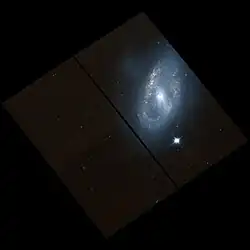| NGC 3729 | |
|---|---|
 NGC 3729 by Hubble Space Telescope | |
| Observation data (J2000 epoch) | |
| Constellation | Ursa Major |
| Right ascension | 11h 33m 49.3s[1] |
| Declination | 53° 07′ 32″[1] |
| Redshift | 1,060 ± 1 km/s[1] |
| Distance | 65.7 ± 4.8 Mly (20.2 ± 1.5 Mpc)[1] |
| Apparent magnitude (V) | 11.0 [2] |
| Characteristics | |
| Type | SB(r)a pec [1] |
| Apparent size (V) | 2.8′ × 1.8′[1] |
| Other designations | |
| UGC 6547, CGCG 268-051, MCG +09-19-117, PGC 35711[1] | |
NGC 3729 is a barred spiral galaxy located in the constellation Ursa Major. It is located at a distance of circa 65 million light years from Earth, which, given its apparent dimensions, means that NGC 3729 is about 60,000 light years across. It was discovered by William Herschel on April 12, 1789.[3]
NGC 3729 has a bright nucleus embedded in a bar which measures 0.5 x 0.1 arcminutes. At the end of the bar lies a ring with knots. The outer part of the galaxy is formed by an asymmetric faint nebulosity with condensations.[4] It is possible that the condensation is a disturbed satellite galaxy.[5] In the centre of NGC 3729 is predicted to lie an intermediate-mass black hole, whose mass is estimated to be between 4 and 400 thousands M☉ (104.6 ± 1.0 M☉) based on Ks-band bulge luminosity.[6] The galaxy has an inner ring which emits in far ultraviolet and H-alpha, which are considered to be markers of recent star formation activity.[7]
NGC 3729 is member of the M109 Group[8] which is part of the south Ursa Major groups, part of the Virgo Supercluster.[9] It forms a pair with NGC 3718, which lies 11.5 arcminutes to the west.[4] It is possible the two galaxies interacted in the past.[10]
Although no supernovae have been observed in NGC 3729 yet, a luminous red nova, designated AT 2018hso, was discovered on 31 October 2018 (type LRN, mag. 19.4).[11]
References
- 1 2 3 4 5 6 7 "NASA/IPAC Extragalactic Database". Results for NGC 3729. Retrieved 2019-01-18.
- ↑ "Revised NGC Data for NGC 3729". spider.seds.org. Retrieved 25 November 2018.
- ↑ NGC 3729 cseligman.com
- 1 2 de Vaucouleurs, Gerard Henri; de Vaucouleurs, Antoinette; Shapley, Harlow (1964). Reference catalogue of bright galaxies. Austin: University of Texas Press. Bibcode:1964rcbg.book.....D.
- ↑ Morales, Gustavo; Martínez-Delgado, David; Grebel, Eva K.; Cooper, Andrew P.; Javanmardi, Behnam; Miskolczi, Arpad (29 June 2018). "Systematic search for tidal features around nearby galaxies". Astronomy & Astrophysics. 614: A143. arXiv:1804.03330. doi:10.1051/0004-6361/201732271. S2CID 118981195.
- ↑ Graham, Alister W.; Scott, Nicholas (1 February 2013). "The MBH-lspheroid relation at high and low masses, the quadratic growth of black holes, and intermediate-mass black hole candidates". The Astrophysical Journal. 764 (2): 151. arXiv:1211.3199. Bibcode:2013ApJ...764..151G. doi:10.1088/0004-637X/764/2/151. S2CID 96428441.
- ↑ Comerón, S. (9 July 2013). "Inner rings in disc galaxies: dead or alive". Astronomy & Astrophysics. 555: L4. arXiv:1306.4515. Bibcode:2013A&A...555L...4C. doi:10.1051/0004-6361/201321983. S2CID 56144824.
- ↑ Makarov, Dmitry; Karachentsev, Igor (21 April 2011). "Galaxy groups and clouds in the local (z~ 0.01) Universe". Monthly Notices of the Royal Astronomical Society. 412 (4): 2498–2520. arXiv:1011.6277. Bibcode:2011MNRAS.412.2498M. doi:10.1111/j.1365-2966.2010.18071.x. S2CID 119194025. Archived from the original on 31 January 2016. Retrieved 19 February 2019.
- ↑ "The Ursa Major Groups". www.atlasoftheuniverse.com.
- ↑ Markakis, K.; Dierkes, J.; Eckart, A.; Nishiyama, S.; Britzen, S.; García-Marín, M.; Horrobin, M.; Muxlow, T.; Zensus, J. A. (20 July 2015). "Subaru and e-Merlin observations of NGC 3718". Astronomy & Astrophysics. 580: A11. arXiv:1504.03691. doi:10.1051/0004-6361/201425077. S2CID 56022608.
- ↑ Transient Name Server entry for AT 2018hso. Retrieved 10 November 2023.
External links
 Media related to NGC 3729 at Wikimedia Commons
Media related to NGC 3729 at Wikimedia Commons- NGC 3729 on WikiSky: DSS2, SDSS, GALEX, IRAS, Hydrogen α, X-Ray, Astrophoto, Sky Map, Articles and images